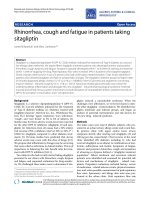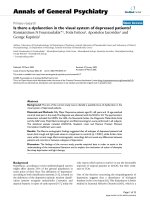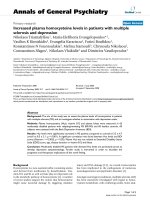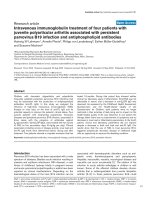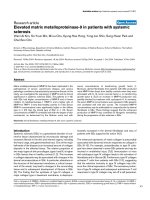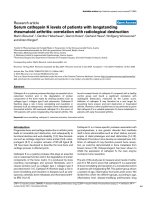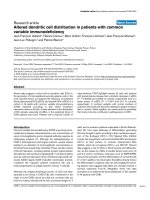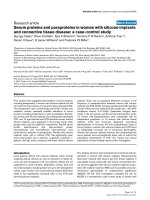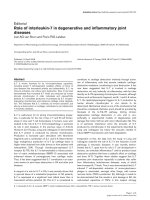Báo cáo y học: "Is albumin use SAFE in patients with traumatic brain injury" potx
Bạn đang xem bản rút gọn của tài liệu. Xem và tải ngay bản đầy đủ của tài liệu tại đây (121.05 KB, 3 trang )
Expanded Abstract
Citation
Myburgh J, Cooper DJ, Finfer S, Bellomo R, Norton R, Bishop N, Kai LS, Vallance S: Saline or albumin for uid
resuscitation in patients with traumatic brain injury. N Engl J Med 2007, 357:874-884 [1].
Background
The Saline versus Albumin Fluid Evaluation study
suggested that patients with traumatic brain injury resuscitated
with
albumin had a higher mortality rate than those resuscitated
with saline. The SAFE investigators conducted a post hoc
follow-up study of patients
with traumatic brain injury who were enrolled in the study.
Methods
Objective: The aims of the study were to document baseline characteristics
that are known to in uence outcomes
from traumatic brain injury
in the albumin and saline groups and to compare death and functional
neurologic
outcomes in the two groups 24 months after randomization.
Design: A post hoc follow-up study of patients with traumatic brain injury who were enrolled in the SAFE study.
Setting: Intensive care units of 16 academic tertiary hospitals in Australia and New Zealand.
Subjects: 460 patients 18 years or older with traumatic brain injury (i.e., a history
of trauma, evidence of head trauma
on a computed tomographic
[CT] scan, and a score of ≤13 on the Glasgow Coma Scale [GCS]).
Intervention: 231 (50.2%) received
four percent albumin and 229 (49.8%) received saline.
Outcomes: The primary outcome measures were the mortality rate and functional neurologic outcome 24 months
after randomization. Multivariate logistic-regression was used to adjustment for baseline covariates known to be
associated with increased mortality from traumatic brain injury (age older than 60 years, GCS score of 8, systolic
pressure of <90 mm Hg, and traumatic subarachnoid hemorrhage). Analyses were conducted in all patients and in
subgroups according to severity of traumatic brain injury.
Results
The subgroup of patients
with GCS scores of 3 to 8 were classi ed as having severe brain
injury (160 [69.3%] in the
albumin group and 158 [69.0%] in
the saline group). Demographic characteristics and severity of brain injury were
similar at baseline. At 2 years,
71 of 214 patients in the albumin group (33.2%) had died, as
compared with 42 of 206
in the saline group (20.4%) (relative
risk, 1.63; 95% con dence interval [CI], 1.17 to 2.26; P=0.003).
Among patients with
severe brain injury, 61 of 146 patients
in the albumin group (41.8%) died, as compared with 32 of 144
in the saline
group (22.2%) (relative risk, 1.88; 95% CI, 1.31
to 2.70; P<0.001); among patients with GCS scores of 9 to
12, death
occurred in 8 of 50 patients in the albumin group
(16.0%) and 8 of 37 in the saline group (21.6%) (relative risk,
0.74;
95% CI, 0.31 to 1.79; P=0.50).
Conclusions
In this post hoc study of critically ill patients
with traumatic brain injury, uid resuscitation with albumin
was
associated with higher mortality rates than was resuscitation
with saline. (Current Controlled Trials number,
ISRCTN76588266.)
© 2010 BioMed Central Ltd
Is albumin use SAFE in patients with traumatic
brain injury?
Christopher R Brackney,
1
Luis A Diaz,
2
Eric B Milbrandt,
3
Ali Al-Khafaji
3
and Joseph M Darby*
4
University of Pittsburgh Department of Critical Care Medicine: Evidence-Based Medicine Journal Club, edited by Eric B Milbrandt
JOURNAL CLUB CRITIQUE
*Correspondence:
4
Professor, Department of Critical Care Medicine, University of Pittsburgh School of
Medicine, Pittsburgh, Pennsylvania, USA
Full list of author information is available at the end of the article
Brackney et al. Critical Care 2010, 14:307
/>© 2010 BioMed Central Ltd
Commentary
Traumatic brain injury (TBI) is devastating with catas-
trophic consequences. Early recognition of injury and
prompt delivery of focused care of the traumatic brain
injured patient is essential to patient outcome. Resusci-
tative fl uids are one of the cornerstones in the manage-
ment of the critically ill. For years, there has been debate
regarding the optimal choice of fl uids in the traumatic
brain injured population. Central to this debate has been
the relative merits of albumin versus saline. In 1998, a
meta-analysis by the Cochrane Injuries Group concluded
that the administration of albumin containing fl uids to
the critically ill increased absolute risk of death by 6% [2].
Following this fi nding, uncertainty about the best choice
of fl uids persisted due to a lack of adequately powered
randomized, controlled trials. Subsequently, a large, multi-
center trial, the Saline versus Albumin Fluid Evaluation
(SAFE) trial, found no diff erence in 28-day mortality for
critically ill patients resuscitated with albumin versus
saline [3]. Subgroup analysis of SAFE participants
suggested an increased number of deaths among patients
with TBI who received albumin. e clinical signifi cance
of these fi ndings were unclear due to lack of baseline data
about factors known to be associated with increased
mortality from traumatic brain injury and concern about
the use of short-term outcomes when outcomes between 6
and 24 months are recommended after TBI.
To determine the potential signifi cance of this fi nding,
the SAFE study investigators undertook this post-hoc
analysis (SAFE-TBI) [1], which included obtaining rele-
vant baseline characteristics from case report forms,
clinical records, and CT scans, and a determination of
vital status and functional neurologic outcomes 24months
after randomization. e authors compared mortality
and functional neurologic outcomes
in patients with TBI
in the saline and albumin groups at two years after
randomization and used multivariate logistic-regression
to adjustment for baseline covariates known to be
associated with increased mortality from traumatic brain
injury. Analyses were conducted in all patients and in
subgroups according to severity of traumatic brain injury.
e authors found that resuscitation with albumin was
associated with higher mortality rates. Furthermore,
there were signifi cantly fewer favorable neurologic out-
comes at 24 months in the albumin group. However, this
diff erence appeared to be due to the greater mortality
rates in the albumin group, since functional outcomes in
survivors were similar between groups. When stratifi ed
by TBI severity, the increase in unfavorable outcomes
seen with albumin were only signifi cant in those with
severe TBI (GCS score of 3-8).
SAFE-TBI is a well done post-hoc analysis. e two
groups were well balanced in terms of baseline
characteristics, the follow-up at two years was excellent
(90%), the results were very consistent, the diff erences in
mortality were quite large, and the conclusion drawn was
consistent with the fi ndings. e study has a few weak-
nesses that deserve mention. Because it is a post-hoc
subgroup analysis, it can only suggest associations and
cannot prove a cause-eff ect relationship between albumin
and mortality due to the potential for chance subgroup
fi ndings. ough patients were randomized and investi-
gators blinded to which fl uid patients were receiving, it
remains possible that there were diff erences in the
clinical management of their TBI, something which the
authors were unable to capture.
Based on the results of SAFE-TBI and other studies, the
Cochrane group concluded that there is no evidence
from randomized controlled trials in critically ill or
trauma patients that resuscitation with colloids compared
to crystalloids reduces the risk of death [4]. Notwith-
standing, recent studies of experimental TBI in mouse
models have renewed interest in the use of colloids [5,6].
Baker and colleagues demonstrated enhanced electro-
physio logical recovery with albumin versus saline resus-
citation [5]. Exo and colleagues found that colloids
exhibited favorable eff ects on acute resuscitation
parameters versus hypertonic saline or lactated ringers
and that colloid use did not increase hippocampal
neuronal death [6]. To explore the effi cacy of albumin as
a neuroprotective agent for TBI in humans, a randomized
controlled trial, Albumin for Intracerebral Hemorrhage
Intervention (ACHIEVE), is currently underway [7].
Recommendation
e fi ndings of SAFE-TBI are another important addition
to the unfavorable existing literature concerning the
superiority of colloid over crystalloid. Based on the
current evidence and the fact that albumin is far more
expensive than crystalloids, it seems reasonable to avoid
the use of albumin when resuscitating patients with
severe TBI. Adequately powered randomized controlled
trials will be needed to defi nitely answer the question of
which resuscitation fl uid to use in TBI.
Competing interests
The authors declare no competing interests.
Author details
1
Clinical Fellow, Department of Critical Care Medicine, University of Pittsburgh
School of Medicine, Pittsburgh, Pennsylvania, USA.
2
Resident, Department
of Internal Medicine, Geisinger Medical Center, Danville, Pennsylvania, USA.
3
Assistant Professor, Department of Critical Care Medicine, University of
Pittsburgh School of Medicine, Pittsburgh, Pennsylvania, USA.
4
Professor,
Department of Critical Care Medicine, University of Pittsburgh School of
Medicine, Pittsburgh, Pennsylvania, USA,
Published: 9 April 2010
References
1. Myburgh J, Cooper DJ, Finfer S, Bellomo R, Norton R, Bishop N, Kai LS,
Vallance S: Saline or albumin for uid resuscitation in patients with
traumatic brain injury. N Engl J Med 2007, 357:874-884.
Brackney et al. Critical Care 2010, 14:307
/>Page 2 of 3
2. Human albumin administration in critically ill patients: systematic review
of randomised controlled trials. Cochrane Injuries Group Albumin
Reviewers. BMJ 1998, 317:235-240.
3. Finfer S, Bellomo R, Boyce N, French J, Myburgh J, Norton R: A comparison of
albumin and saline for uid resuscitation in the intensive care unit. N Engl J
Med 2004, 350:2247-2256.
4. Perel P, Roberts I: Colloids versus crystalloids for uid resuscitation in
critically ill patients. Cochrane Database Syst Rev 2007, CD000567.
5. Baker AJ, Park E, Hare GM, Liu E, Sikich N, Mazer DC: E ects of resuscitation
uid on neurologic physiology after cerebral trauma and hemorrhage.
JTrauma 2008, 64:348-357.
6. Exo JL, Shellington DK, Bayir H, Vagni VA, Janesco-Feldman K, Ma L, Hsia CJ,
Clark RS, Jenkins LW, Dixon CE, Kochanek PM: Resuscitation of traumatic
brain injury and hemorrhagic shock with polynitroxylated albumin,
hextend, hypertonic saline, and lactated Ringer’s: E ects on acute
hemodynamics, survival, and neuronal death in mice. J Neurotrauma 2009,
26:2403-2408.
7. Albumin for Intracerebral Hemorrhage Intervention (ACHIEVE). http://
clinicaltrials.gov/ct2/show/NCT00990509. Accessed 16 Mar 2010.
doi:10.1186/cc8940
Cite this article as: Brackney CR, et al.: Is albumin use SAFE in patients with
traumatic brain injury? Critical Care 2010, 14:307.
Brackney et al. Critical Care 2010, 14:307
/>Page 3 of 3
